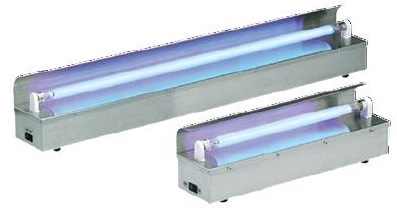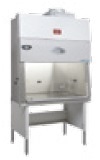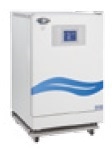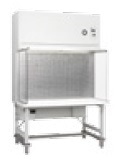Sponsored Content by NuAireNov 12 2018
Following the discovery of microorganisms, biologists started to observe that exposure to sunlight incapacitate multiple varieties of these species. Ultraviolet (UV) bandwidth was discovered in 1801 and according to scientists this invisible energy is responsible for the sun’s dangerous effect.
Following these initial hypotheses, the conclusion of a large body of experimental proof collected over the years enabled modern scientists to determine that almost all bacterial activity can be attenuated or fully eradicated by certain wavelengths of UV energy.
There is a vast diversity of microorganisms in the environment and therefore the rate lysis of each species differs considerably. Due to the development of sterilization technology using ozonation and chlorination, bacteria sterilization – as opposed to species whose domain is general exposure – was stopped around the early 1900s. However, in the past few decades, the industry has increasingly moved towards the use of UV for germicidal purification as it has no toxic chemical by products.
Photochemical Background
Wavelengths between approximately 200 and 400 nanometers are occupied by the ultraviolet bandwidth. To explain it in relative terms, UV radiation is packed between the lower energy visible light and the higher energy, soft X-rays.
Purification through exposure to UV radiation is different from other kinds of sterilization modalities, because it does not always cause the death of the organism in question. In those microorganisms where UV radiation does not kill directly, it effectively modifies the genetic structure of the creature.
By inducing damage to the Deoxyribonucleic Acid (DNA) of the target bacteria, bacterial sterilization is done at the genetic level. Therefore, the organism will not reproduce and cause disease.
Ultraviolet Germicidal Lamps
Many experiments were performed in which the effectiveness of different light sources was compared on the survival ratio of many varieties of bacteria. Based on these experiments, researchers determined the wavelength of UV light which yielded the highest germicidal effectiveness.
This wavelength of UV light was found to be 253.7 nm. This finding demonstrated why solar light is only slightly effective in the treatment of pathogens. This wavelength of UV light is much greater than the short-wave limit of solar light.

Germicidal lamps capable of emitting UV light at a wavelength of 253.7 nm are most effective in the treatment of pathogens. Image credit: NuAire
Applying UV Sterilization to Industry
Sterilization by way of ultraviolet radiation has become a popular method over the last ten years. This technology was adopted by industry because of its safety, convenience, and relative cost effectiveness. Specific application areas are as follows:
- Sterilization of air
- UV water purification systems
- Sterilization within the food industry
The Use of Ultraviolet Lights in Biological Safety Cabinets
UV lights have been traditionally used in biological safety cabinets (BSCs) for a long time. However, the use of UV in a BSC has been dismissed by the present version of the NSF International Standard 49. In their joint pamphlet titled “Primary Containment for Biohazards: Selection, Installation and Use of Biological Safety Cabinets, 2nd Ed”, the NIH and CDC have adopted a similar stand.
To date, the American Biological Safety Association [ABSA] has not made any official pronouncement. Scientists continue to request that lights be fitted in their cabinets, which all manufacturers should provide as an option. At present, 80% to 90% of all United States Class II Type A2 Biological Safety Cabinets developed over the last 15 years are installed with Ultraviolet Germicidal Lights.
Objections
However, the use of UV radiation in a biological safety cabinet presents a number of problems. It has been suggested that UV radiation increases the risk of cancer and ocular damage in researchers.
- The ozone generated by UV radiation can damage the materials inside the cabinet
- The UV radiation is not effective at high humidity levels
- The blue lamp continues to be the same constant blue although the effective radiation no longer exist
- UV radiation only destroys surface bacteria
- UV radiation gives a false sense of security to the researcher
- The UV bulb should be cleaned on a weekly basis to prevent reduced output
“Due to the short time for UV overexposure to occur, it is recommended that neither laboratory nor maintenance personnel work in a room where UV lights are on. The CDC, NIH, and NSF agree that UV lamps are neither recommended nor required in Biological Safety Cabinets (BSC).”
Applied Biosafety. “Position Paper on the Use of Ultraviolet Lights in Biological Safety Cabinets”
Jyl Burgener, Eli Lilly and Company
Although the wide range of our UV-equipped cabinets were utilizing the effects of UV radiation to help with sanitizing the cabinets, BSC users are also utilizing chemical disinfectants such as Isopropanol – the most commonly used disinfectant in tissue culture areas. Hence, it has been disputed that UV radiation is not needed if good aseptic techniques are used to properly disinfect the BSC.
Precautions
- Individuals should never expose themselves to UV radiation. The BSC should not be used when the UV light is on. In majority of BSCs, the fluorescent light is interlocked with the UV light switch with the window remaining in the closed position for the UV light to be on.
- The UV lamp should be wiped clean at least once a week or two.
- The effectiveness of the radiation should be ensured by periodically checking with a UV meter.
- If a spent UV lamp has to be disposed, it should be disposed as hazardous waste.
- Care must be taken because the ozone generated from the radiation can lead to deterioration of rubber or plastics.
- UV radiation should not be substituted by wiping down the interior of the cabinet with a disinfectant.
Germicidal UV Lights in NuAire Equipment
NuAire produces everyday use laboratory equipment with more than 100,000 biological safety cabinets in use across the globe. While UV lights are not always required, they can be found in more than 80% of NuAire biological safety cabinets sold worldwide. In addition, UV lights can prove valuable as an additional defense against contamination and sustain work-zone sterility, besides the regular cleaning sequence.
If users are not aware of the standard operating procedure (SOP) of their facilities with respect to the UV usage, they can consult their Biosafety or Environmental Health and Safety Department Officer to validate their SOP about operating a BSC.
Portable Ultraviolet Lights from NuAire
Portable UV germicidal lights supplied by NuAire are fitted within a BSC, rendering an average intensity of 100 microwatts per centimeter (for a new tube) falling on a horizontal plane, which is defined by the base of the work surface. 40 microwatts per square centimeter (ref. NSF Std. 49 June, 1976) is the minimum requirement per paragraph 5.12 of NSF Standard 49.
Laboratory Equipment Supply from NuAire
NuAire develops scientific laboratory equipment that is ergonomically designed and engineered and provides product, personnel and/or environmental protection in key research environments. NuAire offers the following range of laboratory equipment:



From left to right: Biological Safety Cabinets, Animal Research Products CO2 Incubators. Image credit: NuAire



Laminar Airflow Products, Polypropylene Fume Hoods & Casework, Centrifuges. Image credit: NuAire
References
- Luckiesh, M, Holladay, L. L., Taylor, A. H., “Sterilization through Utilization of Ultraviolet Radiation”, Solar Light Co. 1999
- Meechan, P. J., Wilson, C., “Use of Ultraviolet Lights in Biological Safety Cabinets: A Contrarian View”, Applied Biosafety, 11[4] pp., 222-227 @ ABSA 2006
- University of Minnesota, Environmental Health and Safety, “UV Lights” June 14, 2010
- Burgener, Jyl., “Position Paper on the Use of Ultraviolet Lights in Biological Safety Cabinets”, Applied Biosafety, 11[4] pp., 228-230 @ ABSA 2006
About NuAire
Quality and Service
For more than 40 years, NuAire has been committed to bringing you the highest-quality, most dependable laboratory products on the market.
We are universally recognized as one of the world's leading providers of reliable equipment for the most demanding environments, including Biological Safety Cabinets, CO2 Incubators,Laminar Air Flow workstations, Ultra Low Temperature Freezers, Centrifuges,Animal Transfer Stations, Pharmacy Compounding Isolators, Polypropylene Fume Hoods, Polypropylene Casework, and a variety of complementary products and systems.
You can depend on our products to feature brilliant but practical design, and we pay keen attention to every step of the production process, from fabrication to assembly to thorough testing. As a NuAire customer, you can also rely on us for outstanding value and dependable service - the cornerstones of our reputation as the leading provider of laboratory products internationally.
Committed to Your Success
At NuAire, we create our high-quality products with your success in mind. This means that if you purchase a piece of laboratory equipment from us, we want you to be completely happy while using it.
NuAire will work hand-in-hand with you in order to ensure that your experience using our product meets your standards, and if you encounter any issues or difficulties along the way, we'll help you work through them until you are 100% satisfied. Our philosophy is that we succeed only when you succeed - and we are committed to working hard to ensure you achieve your goals.
Made in America
At NuAire, you can depend on us for being a company that is "Made in America." Our Airflow Products, CO2 Incubators, and Polypropylene Products are manufactured at three locations in Minnesota.
With over 300,000 square feet of manufacturing space, including a state-of-the-art robotic sheet metal facility, NuAire is able to provide employment to 300 Minnesota families and 60 North American sales representatives, and our manufacturing labor is 100% American.
We also purchase our materials from over 500 American vendors, each operating principally in the United States. More than 60% of the raw materials, parts, and supplies for our products originates in the U.S., and an average of 20-30% of the stainless steel flats we use are made from recycled metal.
International Leader
While NuAire is an American company, we also have several international business partnerships, which allow us to better serve you, the global laboratory community. NuAire recently started manufacturing a line of Biological Safety Cabinets in China in order to supply products to the Asian markets via Techcomp, Ltd., a publicly traded Chinese company.
In 2014, NuAire founded an international partnership with Hitachi Koki in order to supply high performance centrifuges to the North American market. NuAire can now provide customers with the sales and service of Hitachi High Speed, Ultra, and Micro Ultracentrifuges.
With several other partnerships with a variety of European and Asian companies, we have sold over 100,000 biological safety cabinets to customers in 150 countries and have equipment located on all 7 continents.
Sponsored Content Policy: News-Medical.net publishes articles and related content that may be derived from sources where we have existing commercial relationships, provided such content adds value to the core editorial ethos of News-Medical.Net which is to educate and inform site visitors interested in medical research, science, medical devices and treatments.